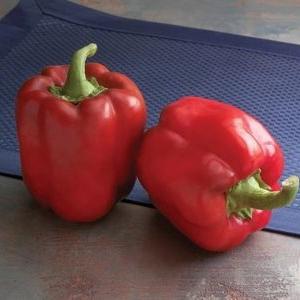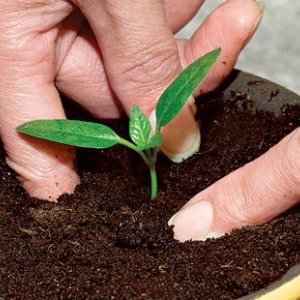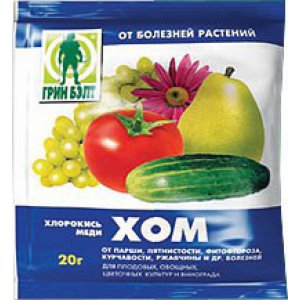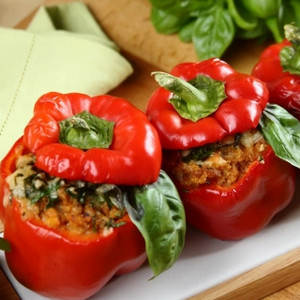Juicy and fruitful "Red Bull" pepper for growing unusually tasty fruits on your site
Bell peppers are a valuable source of vitamins and minerals. A vegetable contains fiber, folic acid, calcium, iodine, iron and many other useful components. In order not to look for tasty and high-quality peppers on store shelves, gardeners prefer to grow them on their own on their site.
When choosing varieties, attention is paid to the taste and marketability, the exactingness of care, the resistance of plants to bad weather. One of the leaders is the Red Bull hybrid. Let's consider its distinctive features.
The content of the article
Description of pepper
Hybrid Red bull f1 combines all the best: large fruits, glossy surface, fleshy pulp and versatility in use. The vegetable is grown mainly in the south and in central Russia.
Distinctive features

The bushes are tall, reach a height of 1.5 m.The leaves are medium-sized, light green color... Medium early hybrid, ripens 90–100 days after planting.
When grown outdoors, the seedling method is used. The red bull has a high immunity to common crop diseases and insect pests.
Fruit characteristics and yield
The fruits are large, the weight of one varies from 200 to 400 g. The color is deep red, the surface is smooth. The walls are dense, the average thickness is 9 mm, which is why the crop can be stored for 2-3 months without losing its taste.
Up to 9 kg of sweet pepper are harvested from 1 m2. The flesh is crispy and juicy, moderately sweet. Contains many vitamins, is widely used in cooking for the preparation of vegetable salads, side dishes and preparations for the winter.
Interesting! Folic acid contained in the pulp of sweet pepper removes toxins from the body. B vitamins serve as an effective prevention of mood swings and insomnia.
Preparation for growing
Peppers are grown in sandy loam beds with a low acidity level. The best precursors are greens, legumes, or onions... It is not recommended to plant the hybrid after potatoes or tomatoes.
At the end of October, the beds are dug up, a layer of peat and compost is added. With the arrival of spring, they dig up again, break up all large lumps, clean them of foliage, debris and weeds. The soil surface should be flat, with clear row spacings. The recommended landing pattern is 70x70. Thickening reduces yield and promotes the development of dangerous bacteria. To lower the acidity of the soil, sprinkle the soil with a mixture of dry wood ash and lime. The procedure is carried out before planting seeds.
Purchase planting material only in trusted stores... It is important that the packaging is intact and that the expiration date has not expired. Seeds are examined for external defects, specimens with damage are removed. The remaining seeds are disinfected with boric acid or Bordeaux liquid. After the seed is germinated: placed in a damp cloth and removed on a sunny windowsill. This strengthens the immunity of future plants and accelerates germination.
Interesting! The method of germinating seeds in sand is also effective. The disinfected seeds are mixed with wet sand in a 1: 4 ratio. The mixture is transferred to small containers and removed to a warm place. After the seeds have hatched, they are transplanted into a seedling container together with sand.
Growing seedlings
It is recommended to grow seedlings in peat tablets or pots. Such containers are inexpensive and are sold in any gardening store. Peat tablets retain moisture and are easy to use. If there is no opportunity to purchase containers, they use cardboard milk bags, flower pots, plastic cups. The main thing is to pre-wash the container and wipe it with a clean towel.
 As a soil, they take land from the garden, mixed with purchased soil. For reliability, the composition is disinfected with a solution of potassium permanganate to kill dangerous bacteria and pathogens. It is recommended to add river sand or sawdust.
As a soil, they take land from the garden, mixed with purchased soil. For reliability, the composition is disinfected with a solution of potassium permanganate to kill dangerous bacteria and pathogens. It is recommended to add river sand or sawdust.
Natural ingredients serve as an excellent baking powder and retain moisture in the soil. Before planting the seeds, the soil is poured into a container and watered abundantly. Next, small pits are made at a distance of about 2 cm from each other. A seed is placed in each, sprinkled with earth on top. Keep seedlings in a warm place.
The soil should always be slightly moist, drying out is unacceptable. For watering, use a pipette so that the water falls directly under the base of the stem. When the first leaves appear, liquid organic fertilizers are applied, for example, chicken manure or a solution based on wood ash. With a lack of light and heat, the peppers are placed under fluorescent lamps in order to accelerate development. Before planting in the garden, seedlings are watered abundantly.
Important! With a rapid growth, a pick is organized. The procedure is essential to ensure the healthy development of the root system. Over time, the roots grow larger and require a larger container. The seedlings are carefully removed and transplanted into another container with a new disinfected soil. When diving, it is recommended to act carefully, without haste, so as not to damage the still fragile stems and leaves.
Landing
Pepper seedlings are planted on pre-prepared beds on a calm and cloudy morning. The seedlings are carefully removed from the container, leaving a lump of wet earth on the roots, placed in the holes in the garden bed, sprinkled and patted with the palm of your hand.
It is recommended to cover each plant with a plastic bag or plastic wrap for the first week. This will protect the sprouts from rain, wind and possible frost. In the future, the hybrid needs a garter, so a wooden peg is installed in advance near each bush.
Further care
The basis of any care is timely and regular watering... The hybrid is moistened once every 5-6 days, about 1.5 liters of water is needed for 1 bush. If the summer is hot and rainy, the amount of watering is reduced. Before the procedure, the beds are loosened to improve the quality of the soil and retain moisture in the ground. The optimum loosening depth is 10-15 cm.
The plant is fed 3-4 times during the ripening period. The first feeding is organized 2 weeks after landing on the site. Slurry, wood ash, superphosphate, ammonium nitrate are used as fertilizers.
It is recommended to alternate mineral and organic fertilizers. Also, you can not do without foliar dressing. To strengthen the immune system, the plants are sprayed with a solution of whey or Bordeaux liquid.
Features of cultivation and possible difficulties
A tall plant needs a binding garter. Pepper stems are very fragile, so they can break under the weight of ripe fruits. To prevent this, each skeletal branch is tied to the support separately. It is important to wipe the pegs with a disinfecting solution before the procedure.
It is impossible to get a rich harvest without forming a bush. Too long shoots and branches are shortened with garden shears, and the top is pinched. If this is not done, there will be a lot of fruits, not everyone will not have enough strength for development, and the peppers will remain small.
When growing a vegetable in a greenhouse, a number of important rules are observed:
- They regularly ventilate the building, open doors and vents.
- The bushes are watered strictly at the root, spending 1-2 liters of water for each.
- Huddle and loosen the aisles to prevent insects.
- During the flowering period, the bushes are shaken to activate pollination.
Typical diseases and pests
Diseases appear due to non-compliance with the rules of crop rotation, improper care, contaminated land. To prevent the occurrence of diseases, it is recommended to follow the watering and feeding regime, use proven seed producers.
What diseases is Red Bull pepper prone to:
- Root rot affects bushes at the stage of seedling development. In this case, a white bloom appears on the roots. For treatment use the drug "Topaz" or "Quadris".
- Powdery mildew manifests itself as white worn on leaves and stem. If measures are not taken in time, the fruits are deformed, lose their elasticity. To combat the disease, a solution of copper sulfate or wood ash is used.
- Tobacco mosaic occurs due to contaminated soil and hot summers. Leaves are covered with a yellow-brown pattern. For treatment, use the drug "Kemira" or spraying with "HOM".
Of the pests, wireworms, slugs, whiteflies and Colorado beetles are noted. An excellent preventive measure against them is regular weeding of beds and removal of weeds.
We recommend that you periodically inspect the bushes for pests. To get rid of insects, they use professional products: Typhoon, Vectra, Maxim.
Advantages and disadvantages of the variety
The Red Bull hybrid has excellent immunity to cold and rainy weather. The following benefits are also noted:
- high productivity;
- sweet and fleshy pulp;
- the ability to grow both in the open field, so in the greenhouse;
- resistance to diseases and pests.
Of the shortcomings, the need for a garter and the formation of a bush is noted. Many hybrids do not need these treatments.
Similar species

The Red Bull has "brothers" - the Yellow Bull and Orange Bull peppers. Mid-early Yellow Bull is a hybrid with large, rich yellow peppers. The shape is truncated, slightly elongated. Fruit weight varies from 200 to 300 g, average length - 20 cm. The pulp is juicy and thick, the skin is thin. The vegetable is grown in warm regions of the country.
The orange bull is orange-brown in color. Ripens in 100-110 days. The taste is juicy, without bitterness. The peel is dense, so the crop can be stored for 2-3 months without loss of taste and marketability. Great for cooking and fresh consumption.
Important! The cultivation technique is the same for all peppers. The main thing is to water and fertilize the beds on time, loosen the soil and remove weeds.
Reviews
Some gardeners plant only the Red Bull hybrid on their site, others prefer varieties that are less whimsical in care. Let's study a few reviews of experienced summer residents.

Olga, Saratov: “Red Bull Pepper is a great hybrid. I like it because of its juiciness and sweetness. I use it for the preparation of winter preparations. The dishes are delicious and healthy! "
Irina, Ufa: “I plant the hybrid only in the greenhouse. I water it early in the morning to avoid sunburn. I fertilize with superphosphate and ash. The yield is good, I collect up to 3 kg from one bush. "
Mikhail, Moscow: “The Red Bull hybrid last year got sick with powdery mildew. It was possible to cure, but 80% of the crop died. I won't plant it anymore, I try vegetables that are more resistant to diseases. "
Read also:
The best hybrids and varieties of peppers for polycarbonate greenhouses.
What is good about the "Ogonyok" pepper variety and how to grow it properly at home.
Conclusion
The high-yielding Red Bull pepper is so named for a reason: the rich scarlet fruits grow large and heavy. Tall bushes, because of this, need a timely garter, which is provided by a pre-prepared support.
The vegetable is planted in bright and sunny areas.The best predecessors are legumes or greens. Watered as the earth dries up, about 1.5 liters of water are consumed per bush. Harvested in mid-August, pluck the peppers together with the stalk. Thanks to the dense skin, the crop is stored for a long time. Pepper is versatile in use, suitable for appetizers, casseroles, salads and soups.